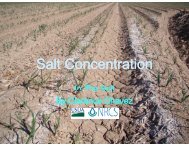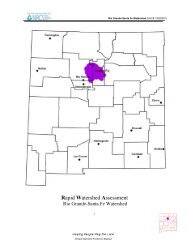SAMPLING VEGETATION ATTRIBUTES - New Mexico NRCS - US ...
SAMPLING VEGETATION ATTRIBUTES - New Mexico NRCS - US ...
SAMPLING VEGETATION ATTRIBUTES - New Mexico NRCS - US ...
You also want an ePaper? Increase the reach of your titles
YUMPU automatically turns print PDFs into web optimized ePapers that Google loves.
METHODS—Daubenmire<br />
b Ten Cover Classes Where narrower and more numerous classes are preferred,<br />
a ten-cover class system can be used.<br />
c Collecting Cover Data As the quadrat frame is placed along the tape at the<br />
specified intervals, estimate the canopy coverage of each plant species. Record<br />
the data by quadrat, by species, and by cover class on the Daubenmire form (see<br />
Illustration 9). Canopy coverage estimates can be made for both perennial and<br />
annual plant species.<br />
(1) Observe the quadrat frame from directly above and estimate the cover<br />
class for all individuals of a plant species in the quadrat as a unit. All other<br />
kinds of plants are ignored as each plant species is considered separately.<br />
(2) Imagine a line drawn about the leaf tips of the undisturbed canopies (ignoring<br />
inflorescence) and project these polygonal images onto the ground. This<br />
projection is considered “canopy coverage.” Decide which of the classes the<br />
canopy coverage of the species falls into and record on the form.<br />
(3) Canopies extending over the quadrat are estimated even if the plants are<br />
not rooted in the quadrat.<br />
(4) Collect the data at a time of maximum growth of the key species.<br />
(5) For tiny annuals, it is helpful to estimate the number of individuals that<br />
would be required to fill 5% of the frame (the 71- x 71-mm area). A quick<br />
estimate of the numbers of individuals in each frame will then provide an<br />
estimate as to whether the aggregate coverage falls in Class 1 or 2, etc.<br />
(6) Overlapping canopy cover is included in the cover estimates by species;<br />
therefore, total cover may exceed 100 percent. Total cover may not reflect<br />
actual ground cover.<br />
9. Calculations Make the calculations and record the results in the appropriate<br />
columns on the Daubenmire form (see Illustrations 9 and 10).<br />
a Canopy Cover Calculate the percent canopy cover by species as follows:<br />
(1) On the Daubenmire form (Illustration 9) count the number of quadrats in<br />
each of the six cover class (by species) and record in the Number column<br />
on the Daubenmire Summary form (Illustration 10).<br />
(2) Multiply this value times the midpoint of the appropriate cover class<br />
(Illustration 10).<br />
(3) Total the products for all cover classes by species.<br />
(4) Divide the sum by the total number of quadrats sampled on the transect.<br />
(5) Record the percent cover by species on the form.<br />
57




